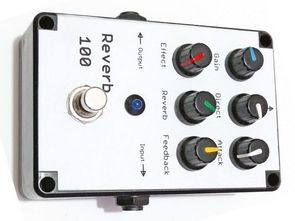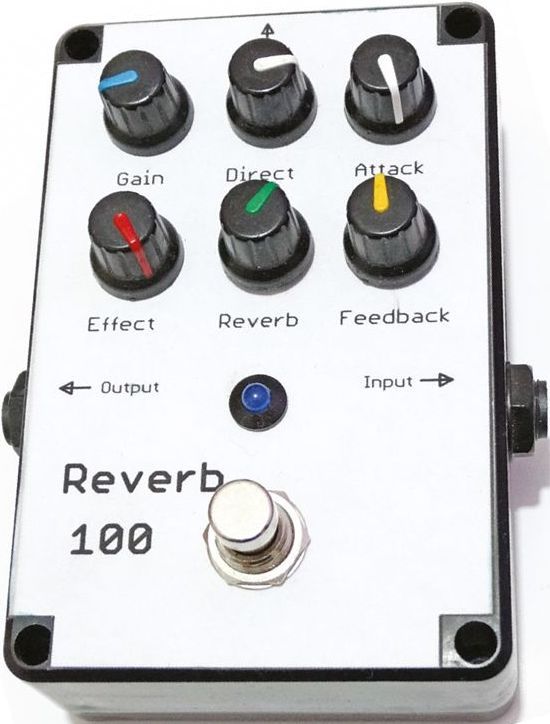
The way to create the “Reverb” effect can be divided into two types: mechanical and electronic, depending on the operation principle. The first and at the same time the oldest solution is the spring arrangement. In the second solution, analogue or digital delay lines are used. Effects built with springs give old-fashioned color, but the range of possibilities for reverberation is very limited. Devices with digital or analogue delay lines allow for much wider reverb range and therefore I decided to use the popular digital PT2399 in my design.
The PT2399 used by me can be used to create other sound effects such as Delay, Reverb, Chorus, Flanger, Stereo Expander. The “Reverb” effect was based on my previous Delay 500 design, so I will limit the principle of operation to the description of system changes.
The “Delay” effect, as the name implies, is obtained by delay (echoes). The resulting delay must be greater than 100 ms, because then the repetitive sound repetition is more noticeable. As a result, Reverb Circuit also has the phenomenon of reflection and repetition, but the time is shorter, which contributes to the overlap of original and repetitive sound, giving an illusion that resembles humming (sound) in an empty room until Loss of the energy of the sound wave and its disappearance.
Reverb PT2399 Circuit diagram
The system assembled from the tested components does not require any additional adjustment. Integrated circuits should be mounted on the cradles so that, in case of startup problems, the chips can be replaced and replaced with new ones, which will allow for easy troubleshooting.
Please note that the PT2399 Circuit is sensitive to electrostatic discharge. It has ESD protection up to 3 kV, but with larger discharges, it can be permanently damaged.
Before placing the PT2399 in the stand, check the voltage available on the output of the Q1 stabilizer (LM78L05) as this system can operate at a maximum supply voltage of 6.5 V and higher voltage will damage it.
The Reverb effect Circuit is powered by +9 V stabilized power from the AC adapter. The rectifier diode 1N4007 is a protection against reverse polarity of voltage.
Reverb Effect sample

FILE DOWNLOAD LINK LIST (in TXT format): LINKS-25875.zip
Publication date: 2017/10/01 Tags: audio control circuits

Reverb Effektschaltung PT2399 Gitarreneffekte
Die Art und Weise, wie der “Reverb” -Effekt erzeugt wird, kann in zwei Arten unterteilt werden: mechanisch und elektronisch, abhängig vom Funktionsprinzip. Die erste und zugleich älteste Lösung ist die Federanordnung. Bei der zweiten Lösung werden analoge oder digitale Verzögerungsleitungen verwendet. Mit Federn gebaute Effekte geben eine altmodische Farbe, aber die Möglichkeiten für Nachhall sind sehr begrenzt. Geräte mit digitalen oder analogen Delay-Linien erlauben einen viel größeren Reverb-Bereich und deshalb entschied ich mich, den beliebten digitalen PT2399 in meinem Design zu verwenden.
Der von mir verwendete PT2399 kann verwendet werden, um andere Soundeffekte wie Delay, Reverb, Chorus, Flanger, Stereo Expander zu erzeugen. Der “Reverb” -Effekt basierte auf meinem früheren Delay 500-Design, daher beschränke ich das Funktionsprinzip auf die Beschreibung von Systemänderungen.
Der “Delay” -Effekt wird, wie der Name sagt, durch Verzögerung (Echos) erhalten. Die resultierende Verzögerung muss größer als 100 ms sein, da sich dann die wiederholte Tonwiederholung bemerkbarer macht. Als Ergebnis hat Reverb Circuit auch das Phänomen der Reflexion und Wiederholung, aber die Zeit ist kürzer, was zur Überlappung des ursprünglichen und sich wiederholenden Klangs beiträgt und eine Illusion erzeugt, die in einem leeren Raum bis zum Verlust der Energie summt der Schallwelle und ihr Verschwinden.
Reverb PT2399 Schaltplan
That’s not reverb; it’s echo. Reverb sounds completely different from this.
That’s not reverb; it’s echo. Reverb sounds completely different from this. You need at least three or four PT2399 circuits to get a non-periodic-sounding reverb effect.